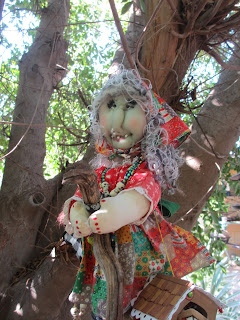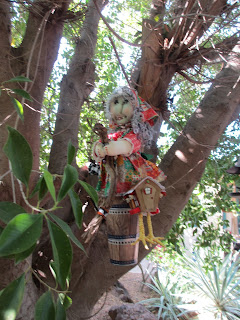My current fascination with the character Baba Yaga came
during a kitchen clean-up. Hanging in
the corner was my kitchen witch, a stuffed doll I had made many years
before. I knew she needed dusting but
something about her seemed “off.” This
benign figure flying on a wooden spoon no longer seemed capable of providing
any protection or blessing to my kitchen at all. This was no Chinese “kitchen god” after all.
The world today, struggling with so much carelessness and cruelty could not be
protected by a mere kitchen witch. I
needed something more and she needed to be more.
That’s when I remembered Baba Yaga, the larger than life
witch found in the Russian fairy tale. If I needed a talisman, Baba Yaga fit the
tenor of the times. It was then that I
decided to transform my kitchen witch into Baba Yaga. In the process, I discovered more about the
story and the two wise crone characters within in it than I could ever have
imagined.
As the creator of one-of-a-kind art dolls, I was used to my
dolls “speaking” to me. But it soon became
clear that I was not making one doll, I was actually making two. In the story of Baba Yaga, the heroine, Vasilissa,
was guided by two crone figures. The
first, was Baba Yaga, who lives in a forest Helen Pilinovsky describes
as “a traditional symbol of change and a place of peril,
where she acts as either a challenger or a helper to those innocents who
venture into her realm.” In this way,
Baba Yaga corresponds to many of the other crone archetypes seen in fairy
tales. Although dark, ferocious and dangerous,
she lives by her own code of ethics. It seemed that in her world, keeping your
word was more important than taking a life (of which there was plenty of
proof). The second character is the
grandmotherly figure who facilitates Vasilissa’s ultimately meeting of the tsar. “In Western tales, these two roles are
typically polarized, split into different characters stereotyped as either ‘witch’
or ‘fairy godmother’,” Pilinovsky writes. “Baba Yaga, however, is a complex
individual: depending on the circumstances of the specific story, she may
choose to use her powers for good or ill.”
To me, there was something unsettling about that part of the
story. Baba Yaga simply allows Vasilissa
to leave after meeting her part of the bargain.
It all seems too easy and the reader wonders whether it is a trick. Is the grandmother figure kind or is she
really Baba Yaga in disguise? There is an uneasy tension here for many folktale
motifs concern transformation of the seemingly good into the frightful (Snow
White’s step-mother, for example) or the evil into the appearance of good (the
Wolf in “Little Red Riding Hood”). Holding
on to the edge of the seat, the reader is waiting for Vasilissa to slip up until
the story ends.
That tension is what unfolded for me as I transformed my
kitchen witch into Baba Yaga. I tried to
make her face into something more fearsome but the more I tried, the more I saw
the blurring of the witch with the crone. To me she looks as if she has tried
to “pretty” herself, but underneath the Shadow appears. In Jungian psychology, the Shadow is the part
of us that remains unknown. It might be
our darkness and it might be our greatest potential. There is much power in
Baba Yaga, so I think that rings true.
Around her neck I placed a necklace of colored beads and human skulls.
Without being aware I created the necklace with the same dichotomy that I did
her face. On her apron I sewed a new pocket.
Into it I placed a wild looking wooden doll. Although this was not true to the story, it
seemed needed.
In the story, Vasilissa is given a doll by her dying
mother. It was a doll that had magical
powers and allowed her to complete all the tasks given to her by Baba Yaga. Without
the tiny doll, Vasilissa would never have completed the tasks given to her to
prove her worth. Maria Tatar writes an explanation, “Whereas Cinderella and
her folkloric cousins usually receive assistance from nature … or from a fairy
godmother, Vasilissa is given a cultural artifact, a figure that can be seen as
a miniaturized version of herself or as a symbolic form of her mother. While
the doll protects and helps Vasilissa, it is also something to be nurtured and
cared for, thus strengthening the fact of her own agency in escaping from
villainy at home.” Accordingly, this wooden doll also became Baba Yaga’s source
of power.
Most witches in Western folklore ride on brooms, instead
Baba Yaga rides in a mortar, rowing with a pestle, and using the broom to erase
her tracks. I placed my doll in a mortar
I fashioned, complete with skulls hanging around the handle. She holds a twisted
branch that both serves as a broom and a pestle. Duality seemed the key to her recreation on
an intuitive level.
Baba Yaga’s house stands on chicken legs. Around it is a wall made with human bones and
on top is a human skull. I crafted a smaller version of this house which I hung
from her arm. The skulls on the fence
were fiery to represent the light she gave to Vasilissa to take home. Inside
the house you can see a nest with an egg.
Again, this is my addition, for the contrast of light and dark ring
strong in this tale. The egg is the
potential for something more.
It is uncertain how many tasks Vasilissa would have been
given if she did not disclose that “the blessing of my dead mother helps me.”
Baba Yaga replies, “I want no one who bears a blessing to cross my threshold!”
Marie-Louis von Franz writes, “Baba Yaga, who here is almost completely evil,
though when she hears that the girl is a ‘blessed daughter’ she tells her she
does not want her in her house. So in a
hidden way, she is not thoroughly evil, and sometimes even helpful…” Remember,
at the end of the story, Vasilissa meets one more crone. This one serves as her
surrogate mother. Marie-Louise von Franz describes her as portraying the Great
Mother in her double aspect. Here she facilitates her meeting and ultimate
marriage with the tsar.
While transforming the doll, I did not consciously seek to
have her embody both aspects. It was the tension I found in reading the story
that led me to this discovery. Not the
tension in the fearsomeness of the Baba Yaga witch, but in the quiet,
helpfulness of the grandmother figure. It’s not just the Shadow and the Light
of these two opposites that makes one uneasy.
That is the norm for the archetypal.
It is instead the living potential for an unexpected appearance of the “other”
that seems so unsettling.
When it was all said and done, it was this unpredictability
that made Baba Yaga so attractive to me.
In a world filled with climate change, raging wannabe despots, injustice
and cruelty; she is sorely needed – both in her mortar flying self with
unlimited power and rage and in her kindly and compassionate alter ego. Each of us as women today may need to connect
to these two archetypal forces. The crone’s
ferocious strength and her compassion to serve those needing help, are required
in a world in crisis.
The wise crone
continually asks, “Who is worthy?” “Who
is worthy?” The answer always rings true to the crone. For the rest of us, the Baba Yaga tale
answers this question thus. “Well, said the old witch, “only remember that
every question does not lead to good. If
thou knowest overmuch, thou wilt grow old too soon. What wilt thou ask?” Marie-Louise Von Franz explains
“How much evil can one afford to see without losing one’s appetite for life? If one has to, if one’s destiny forces one
into it, one has to take it, but to load the boat with evil which is not in one’s
own fate and has been picked up out of sheer curiosity is not recommended.” Such is the challenge for all of us living
today.






